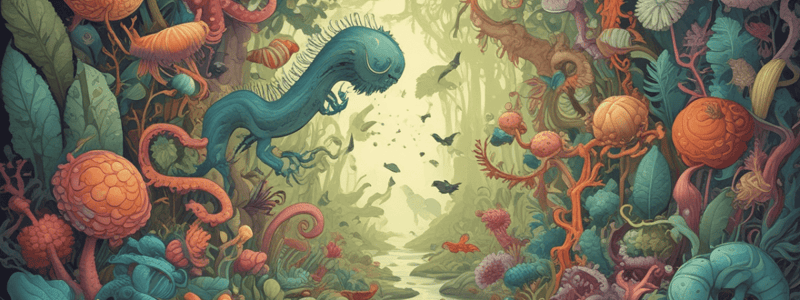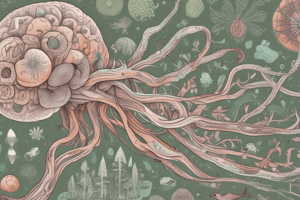Podcast
Questions and Answers
Which branch of biology focuses on the study of interactions between living organisms and their environment?
Which branch of biology focuses on the study of interactions between living organisms and their environment?
- Microbiology
- Botany
- Ecology (correct)
- Zoology
What is the basic structural and functional unit of life?
What is the basic structural and functional unit of life?
- Cells (correct)
- Molecules
- Organelles
- Tissues
Which of the following is NOT a level of biological organization?
Which of the following is NOT a level of biological organization?
- Ecosystem
- Species (correct)
- Biosphere
- Organelle
Which of the following processes converts light energy into chemical energy?
Which of the following processes converts light energy into chemical energy?
What is the study of heredity and genetic variation?
What is the study of heredity and genetic variation?
Which of the following is NOT considered a biological molecule?
Which of the following is NOT considered a biological molecule?
What is the process of cell division that results in two identical daughter cells?
What is the process of cell division that results in two identical daughter cells?
Which of the following is NOT a branch of biology?
Which of the following is NOT a branch of biology?
What is the primary outcome of meiosis?
What is the primary outcome of meiosis?
Which molecule is primarily involved in protein synthesis?
Which molecule is primarily involved in protein synthesis?
What does evolution refer to in biological terms?
What does evolution refer to in biological terms?
What is the role of chromatography in scientific studies?
What is the role of chromatography in scientific studies?
What distinguishes lipids from carbohydrates?
What distinguishes lipids from carbohydrates?
Which technique is used for amplifying specific DNA sequences?
Which technique is used for amplifying specific DNA sequences?
Flashcards are hidden until you start studying
Study Notes
Definition and Scope
- Biology is the scientific study of life and living organisms.
- It encompasses the structure, function, growth, evolution, distribution, and taxonomy of all living things.
Branches of Biology
- Botany: study of plants and plant-like organisms.
- Zoology: study of animals and animal-like organisms.
- Microbiology: study of microorganisms, such as bacteria and viruses.
- Ecology: study of the interactions between organisms and their environment.
- Genetics: study of heredity, genes, and genetic variation.
- Biochemistry: study of the chemical processes that occur within living organisms.
- Molecular Biology: study of the structure, function, and interactions of biological molecules.
Levels of Organization
- Molecules: biological molecules, such as DNA, proteins, and carbohydrates.
- Organelles: specialized structures within cells, such as mitochondria and chloroplasts.
- Cells: the basic structural and functional units of life.
- Tissues: groups of similar cells that perform a specific function.
- Organs: structures composed of two or more types of tissues that work together to perform a specific function.
- Organ Systems: groups of organs that work together to maintain homeostasis and perform specific functions.
- Organisms: individual living things, such as plants and animals.
- Populations: groups of individuals of the same species that live in a specific area.
- Communities: groups of different species that live in a specific area.
- Ecosystems: interactions between living and non-living components of an environment.
- Biosphere: the global sum of all ecosystems on Earth.
Biological Processes
- Photosynthesis: process by which plants and some other organisms convert light energy into chemical energy.
- Cellular Respiration: process by which cells generate energy from glucose.
- Mitosis: process of cell division that results in two identical daughter cells.
- Meiosis: process of cell division that results in four non-identical daughter cells with half the number of chromosomes.
- Homeostasis: ability of an organism to maintain a stable internal environment despite changes in the external environment.
- Evolution: change in the frequency of genes in a population over time.
Biological Molecules
- DNA (Deoxyribonucleic acid): molecule that contains genetic information.
- RNA (Ribonucleic acid): molecule involved in protein synthesis and other cellular processes.
- Proteins: molecules composed of amino acids that perform a wide range of functions.
- Carbohydrates: molecules composed of carbon, hydrogen, and oxygen that provide energy and structure.
- Lipids: molecules composed of carbon, hydrogen, and oxygen that provide energy and structure.
Scientific Tools and Techniques
- Microscopy: use of microscopes to observe and study microscopic structures.
- Chromatography: technique used to separate and identify molecules based on their properties.
- Electrophoresis: technique used to separate and identify molecules based on their charge and size.
- PCR (Polymerase Chain Reaction): technique used to amplify specific DNA sequences.
- Genetic Engineering: technique used to modify an organism's genome by introducing foreign DNA.
Definition and Scope
- Biology encompasses the study of life, exploring structure, function, growth, evolution, distribution, and taxonomy of living organisms.
Branches of Biology
- Botany: Focuses on plants and plant-like organisms.
- Zoology: Examines animals and animal-like organisms.
- Microbiology: Investigates microorganisms, including bacteria and viruses.
- Ecology: Analyzes interactions between organisms and their environment.
- Genetics: Explores heredity, genes, and genetic variation.
- Biochemistry: Studies chemical processes that sustain life within organisms.
- Molecular Biology: Examines the structure and function of biological molecules and their interactions.
Levels of Organization
- Molecules: Includes biological entities like DNA, proteins, and carbohydrates.
- Organelles: Specialized structures within cells, e.g., mitochondria, chloroplasts.
- Cells: The basic units of life with structural and functional integrity.
- Tissues: Collections of similar cells performing specific functions.
- Organs: Composed of two or more tissue types working together for specific tasks.
- Organ Systems: Groups of organs collaborating to maintain homeostasis and perform functions.
- Organisms: Individual life forms, including plants and animals.
- Populations: Groups of the same species residing in a specific area.
- Communities: Various species coexisting in a particular region.
- Ecosystems: Interactions between living (biotic) and non-living (abiotic) components.
- Biosphere: The global collection of all ecosystems on Earth.
Biological Processes
- Photosynthesis: Conversion of light energy into chemical energy by plants.
- Cellular Respiration: Energy production process from glucose within cells.
- Mitosis: Cell division yielding two identical daughter cells.
- Meiosis: Cell division producing four non-identical daughter cells with half the chromosome count.
- Homeostasis: The capacity of organisms to maintain stable internal conditions despite external fluctuations.
- Evolution: Changes in gene frequency in populations over successive generations.
Biological Molecules
- DNA (Deoxyribonucleic acid): Contains genetic blueprints for life.
- RNA (Ribonucleic acid): Critical for protein synthesis and various cellular roles.
- Proteins: Comprised of amino acids, serving multifarious functions in organisms.
- Carbohydrates: Energy-providing molecules composed of carbon, hydrogen, and oxygen.
- Lipids: Structural and energy-rich molecules consisting of carbon, hydrogen, and oxygen.
Scientific Tools and Techniques
- Microscopy: Observes microscopic structures using lenses for magnification.
- Chromatography: Separates and identifies molecules based on physical and chemical properties.
- Electrophoresis: Differentiates molecules by size and charge.
- PCR (Polymerase Chain Reaction): Amplifies specific DNA sequences for genetic analysis.
- Genetic Engineering: Modifies organisms by incorporating foreign DNA to alter genetic features.
Studying That Suits You
Use AI to generate personalized quizzes and flashcards to suit your learning preferences.




